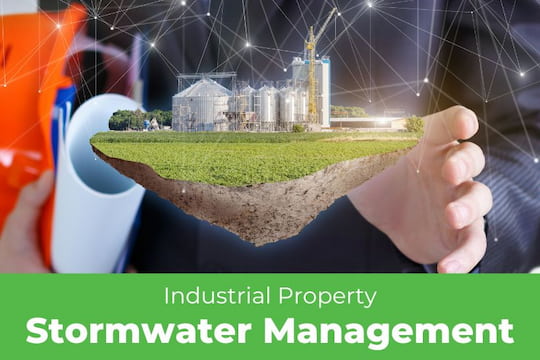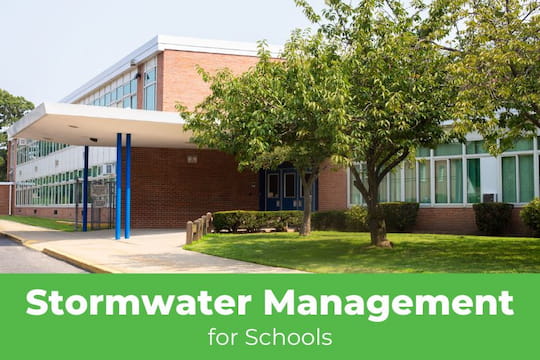Stormwater management is critical to urban planning and infrastructure development because it protects communities by safely and sustainably handling stormwater runoff. However, stormwater engineers and system managers face many challenges in managing their stormwater systems effectively.
These challenges require proactive approaches and innovative solutions. The following represents some of the biggest stormwater system challenges and solutions that stormwater system owners and managers can use to address these issues. While the solutions are not exhaustive, they provide a starting point for further consideration.
1. Urbanization and Increased Impervious Surfaces
When land is urbanized with residential and commercial developments, natural grass or soil areas become impervious surfaces such as roads, buildings, and parking lots. These surfaces keep stormwater from infiltrating the ground, increasing the resulting runoff's volume and velocity. More impervious surfaces lead to higher flood risk, erosion of stream banks, and degradation of local water bodies.
Possible ways to reduce or offset the effects of impervious surfaces include implementing green infrastructure practices, retrofitting existing infrastructure, and reviewing site design considerations. Green infrastructure practices can include permeable pavement, green roofs, and rain gardens, which can be integrated into property designs to promote stormwater infiltration and reduce runoff.
Additionally, low-impact development techniques that use natural drainage features, such as swales and vegetated strips, can minimize impervious surfaces and encourage stormwater infiltration.
2. Aging Stormwater System Infrastructure

Due to various factors, many stormwater systems have aged beyond their intended lifespan. Older systems suffer from pipe corrosion, structural deterioration, and reduced capacity. As the stormwater system's infrastructure ages, the challenge of keeping systems functioning properly increases the risk of failures during storms.
Shoring up aging stormwater infrastructure and ensuring long-term functionality requires regular inspections, condition assessments, and prioritizing maintenance and needed replacements based on a structured plan. Specific, targeted repair and rehabilitation strategies, such as relining drainage pipes, repairing culverts, and reinforcing structures, can help resolve specific infrastructure issues.
Identifying parts of the system with capacity deficiencies and planning for upgrades or expansions is crucial to ensure the stormwater system can handle present and future demands.
3. Climate Change and Increased Storm Intensity
Climate change has triggered more frequent and increasingly intense storms. This weather change places additional pressure on systems designed based on an area's historical rainfall patterns.
With increased storm intensity comes a higher volume of runoff, overwhelmed stormwater management infrastructure, and increased flood risks. Climate change has also brought more uncertainty to rainfall patterns, which makes it difficult to assemble accurate predictions for future stormwater management system planning.
Identifying stormwater system challenges and solutions that address climate change in the immediate term requires engineers to focus on increasing the capacity for stormwater conveyance by upgrading pipes, channels, and culverts to accommodate the higher runoff volumes and velocities.
To address climate change in the future, system upgrade projections and designs for increased storm intensities can use the most recent storm data to guide stormwater infrastructure improvements. For example, advanced hydrologic modeling incorporating climate change data can assess the impact of changing rainfall patterns and guide the design or retrofit of effective stormwater system improvements.
4. Stormwater System Maintenance and Operations

Stormwater systems require a regular schedule of maintenance and efficient operations to ensure they provide adequate functionality and effectiveness.
However, many systems fall prey to inadequate or nonexistent maintenance practices. Additionally, operational challenges can lead to system failures, reduced runoff conveyance capacity, and compromised stormwater management.
Management should develop a comprehensive stormwater system maintenance plan with routine inspections, cleaning schedules, and repair protocols to maintain their stormwater systems effectively. Additionally, implementing operational processes such as an asset management system helps track the system's infrastructure condition and performance.
The ongoing record can enable proactive maintenance and resource prioritization. Additional training for staff and contractors involved in maintenance and operations can ensure the use of proper work techniques, safety protocols, and a better understanding of the stormwater system's components.
5. Limited Staff Knowledge of the System
One of the biggest challenges for stormwater system management is the need for more awareness of stormwater regulations and best management practices among property owners in multifamily developments, HOAs, and other property types.
Property owners or staff's lack of awareness can result in issues with regulatory compliance, inadequate stormwater infrastructure design, improper or insufficient maintenance practices, and increased pollutant loads running into stormwater systems.
To resolve these issues and support stormwater management in multifamily properties and other developments, staff can attend workshops or webinars that provide education that covers regulations and best practices.
For regulatory compliance, managers can establish a stormwater system compliance monitoring and reporting process to help stay on top of regulatory requirements. Third-party firms and other resources can provide technical assistance and guidance in system design, maintenance, and compliance.
6. Funding and Financial Constraints
Stormwater system challenges and solutions often cost money, yet municipalities and other entities that manage stormwater systems often need more funding to meet the system's needs. The financial constraints can cause challenges in implementing new stormwater management projects, conducting routine maintenance, and addressing essential infrastructure upgrades. The limited resources can limit the ability to implement comprehensive stormwater management measures and hinder the timely repair and replacement of aging system infrastructure.
In some cases, system operators can establish stormwater utility fees or charges dedicated to projects, maintenance, and system upgrades to secure funding for stormwater management.
Another option is to seek grants and form partnerships with government agencies, non-profits, and private entities that can provide additional funding opportunities. Working with neighboring municipalities or regional organizations may provide opportunities for cost-sharing and resource pooling to undertake larger-scale stormwater management initiatives that benefit multiple jurisdictions.
7. Lack of Public Awareness and Engagement

A lack of public awareness about stormwater runoff and water pollution makes it challenging to effectively address some of the issues with stormwater management. When the public needs to understand the importance of stormwater management or its role in mitigating stormwater impacts, gaining support for important stormwater initiatives or implementing necessary measures such as pollution control becomes harder.
To help get the public engaged and build awareness regarding stormwater management, system operators can develop educational programs and community events that raise awareness about how stormwater runoff impacts the local environment and the important role that individual actions can play in improving water quality.
Establishing sites within the community to demonstrate stormwater management concepts can provide hands-on learning experiences for all ages and highlight the benefits of responsible stormwater management. Using social media platforms, websites, and online forums allows organizations to share stormwater-related information and success stories, which can foster ongoing engagement and dialogue with the public.
Get the Resources You Need
Effective stormwater management requires operators to use proactive measures and innovative solutions to address the systems' many challenges. By implementing solutions such as green infrastructure practices and prioritizing maintenance and infrastructure upgrades, organizations can better manage stormwater runoff while ensuring the safety and sustainability of their stormwater management infrastructure.
Collective efforts and continuous improvement can help protect the public, communities, and the environment from the impacts of stormwater runoff.
Schedule a storm water cleanout if your system needs maintenance for solid debris buildup or chemical pollutants that reduce runoff water quality. If you have regulatory or other stormwater system challenges, contact CatchAll Environmental today to see how we can help you implement economical and effective solutions to positively impact your stormwater management system operations.













.jpg)


